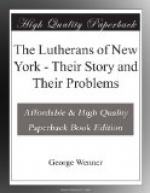[illustration: “In the Eighteenth Century”]
A later descendant was Dr. William A. Muhlenberg,
born in Philadelphia, September 16th, 1796, the venerated
founder of St. Luke’s Hospital in this city.*
Dr. Muhlenberg was
the rector of the Protestant Episcopal Church
of the Holy Communion. He was one of the best
beloved ministers in New York. He died in 1877.
I visited him during his last illness in St. Luke’s
Hospital. As I took my leave he threw his arms
about me and assured me that he had always been a
Lutheran. He evidently conceived of Lutheranism
in broader terms than merely denominational distinctions.
Among the Palatine immigrants stranded on Governor’s Island, unable to follow their sturdier companions to the upper part of the Hudson Valley, were widows, elderly men and 80 orphans. One of these orphans was Peter Zenger, who was apprenticed to William Bradford, at that time the only printer in the colony. When he grew up, he became the editor of The Weekly Journal, which made its first appearance on November 5th, 1733. Washington at this time was not yet two years old. Zenger was one of the earliest champions of American liberty. His arrest and imprisonment, his heroic defence and final acquittal, are among the milestones of American history and are a contribution to the story of New York of which Americans of German descent may well be proud.
It was a large parish to which Falckner ministered. There were no Home Mission Boards in those days. The New York pastor had therefore to care for many outlying stations. His diocese included Hackensack, Raritan, Ramapo and Constable Hook in the south, and Albany, Loonenburg and West Camp in the north. After the death of Kocherthal he visited regularly, not only the Dutch congregations of Claverack, Coxackie and Kinderhook, but also such German settlements as East Camp, Rhinebeck, and Schoharie.
New York itself was not neglected during these missionary journeys. Readers (Vorleezers) conducted the service while he was away. Such notices as “There will be no church today, the minister is out of town,” did not appear on his bulletin board.
The care of a parish 150 miles in length left but little time for literary work, but in order that his people might be informed on the subject of their church’s faith as distinguished from that of their Calvinistic neighbors, he wrote a book on the essential doctrines of the Lutheran confession. It was published by William Bradford, New York, 1708.
He also wrote a hymn: "Auf, ihr Christen, Christi Glieder," which after two centuries holds a place in German hymnals, and the translation is to be found in some of the best collections of the English language. To this day, therefore, the churches of London and Berlin alike respond to Falckner’s rallying call: “Rise, ye children of salvation.”
[illustration: “Trinity Church, Broadway and Rector Street, (Southwest Corner)”]




